It is a great mistake to imagine the Wars of the
Roses as some latter-day Roses cricket match, with the Red Rose county of
Lancashire and the White Rose county of Yorkshire fighting it out for victory.
The real War of the Roses had little to do with the neat geographical
distinctions between the opponents and everything to do with the noble Houses
of Lancaster and York. In fact, many noble families in Lancashire allied
themselves to the Yorkist faction and, similarly, many Yorkshire families
fought on the Lancastrian side, as England was riven by political, financial
and social in-fighting as the Hundred Years War with France came to an end.
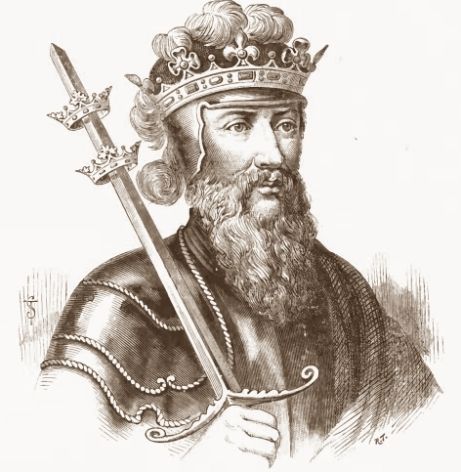 |
| King Edward III |
The
leading contenders for the throne of England came from the Plantagenet Kings,
notably the offspring of Edward III. His son, Edward the Black Prince, died one
year before his father and the crown passed to the Black Prince’s son, who
became King Richard II.
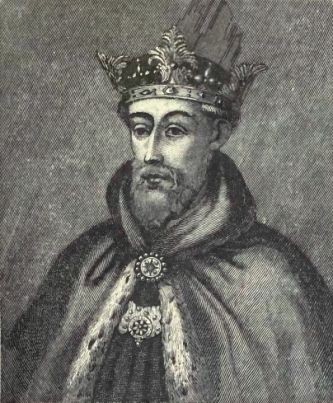 |
| John of Gaunt |
King Edward III’s third son, John of Gaunt, had a son,
Henry Bolingbroke, who eventually deposed his cousin, Richard II, and declared
himself King Henry IV, the first of the Lancastrian Kings of England.
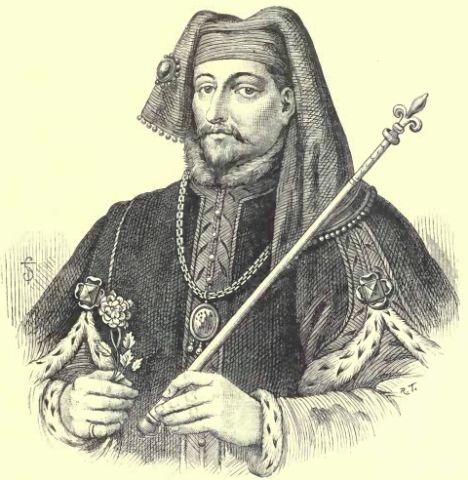 |
| King Henry IV |
His son,
Henry V, carried on the Lancastrian line, and he was followed by his infant
son, Henry VI.
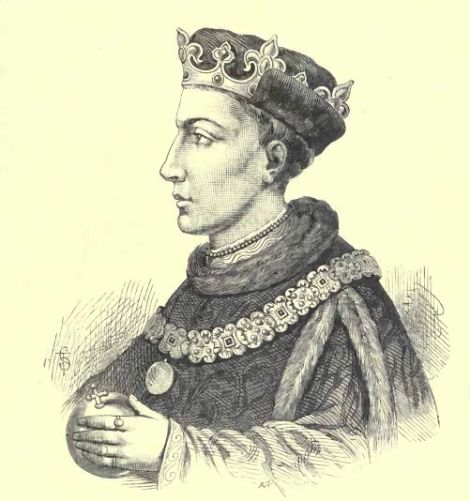 |
| King Henry V |
During, and following, the regency of Henry VI, the Yorkist side
of the Plantagenet family gained influence and power, and Henry was deposed,
twice, by Edward IV, who was the great-grandson of King Edward III. Edward IV
was then followed by his brother, Richard III, who has had his reputation
blackened by later historians.
 |
| Richard III accepts the crown |
He is said to have had a hand in the murder of
Henry VI, his brothers Edward IV and George, Duke of Clarence, his nephews King
Edward V and Richard, Duke of York, and numerous others who stood in his way to
the throne. As you will appreciate from all this, the family threads of the
later Plantagenets were very tangled, and just as Richard III thought that he
might form them into a single strand, another distant relative made a bid for
the crown.
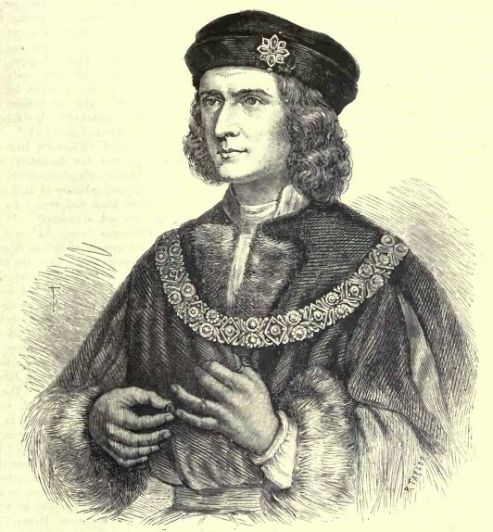 |
| King Richard III |
Henry of Richmond, was an unlikely contender, his father had died
three months before he was born, his claim came through his mother, Margaret
Beaufort, who was thirteen when he was born, and was a great-granddaughter of
John of Gaunt’s third marriage, by children who had been born out of wedlock
but later legitimised by Richard II, (who had added a clause of doubtful
legality denying that branch of the family any claims of succession). It was a
tenuous, but nonetheless, valid relationship, strengthened a little by links to
the Welsh Tudors. Young Richmond spent most of his life in exile, in France and
Brittany, where his mother, who had remarried into the Yorkist Stanley family,
promoted his claim to the throne.
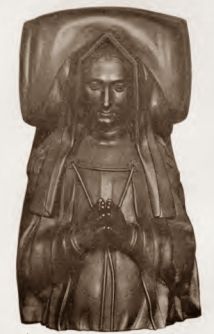 |
| Elizabeth of York |
In 1483, Richmond was betrothed to Elizabeth
of York, their marriage would unite the Yorkist and Lancastrian lines of the
family. In October, an unsuccessful invasion was planned from Brittany but
terrible weather turned them back. Richard III was aware of the plans against
him and took steps to counter Richmond’s claims, but his own dynastic dreams
received a fatal blow when Edward, his ten year old son, died unexpectedly.
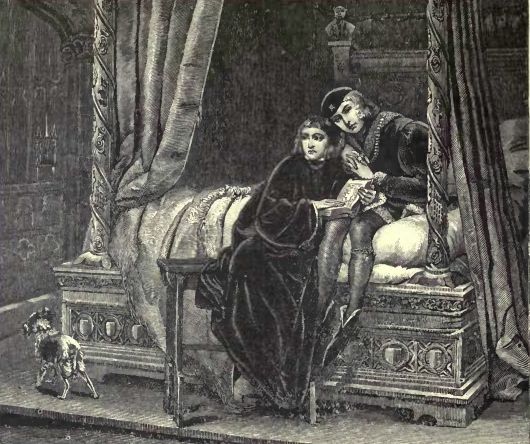 |
| Princes in the Tower |
Richard had had plans for this son Richard to marry Elizabeth of York, daughter
of Edward IV, sister of the Princes in the Tower and his own niece; now he
considered murdering his wife, Anne Neville, (widow of Edward, son of Henry VI)
in order to marry her himself, thus thwarting Richmond’s plans of uniting the
Yorkist and Lancastrian branches of the family.
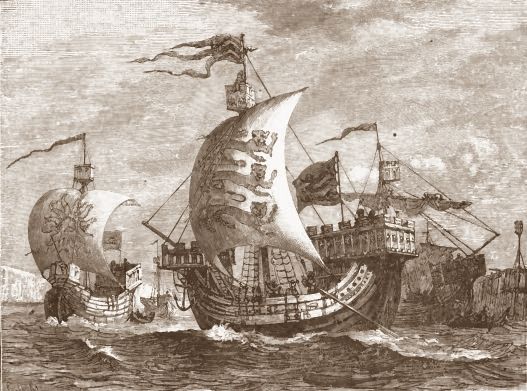 |
| Sailing for England |
On August 1st 1485,
Richmond and an army of exiles, Scots and French mercenaries sailed from
Harfleur and landed at Mill Bay, near Milford Haven, Pembrokeshire, seven days
later. His Welsh family connections brought him support from the Welsh, and
others joined him from the north, as they marched east, through Wales and into
Leicestershire, where Richard was waiting with a massed army (although Stanley
alone did not join him, claiming to be suffering from the sweating sickness).
 |
| Richard III rides out |
On August 21st, Richard rode out from Leicester to Bosworth, two
miles away, at the head of 30,000 men, including the finest cavalry in Europe;
Richmond was at Atherstone, his forces barely half the size of Richard’s. Here
he met Stanley, who assured him of support although he could not act at once,
as Richard was holding his son, Lord Strange, as a virtual hostage to ensure
his loyalty.
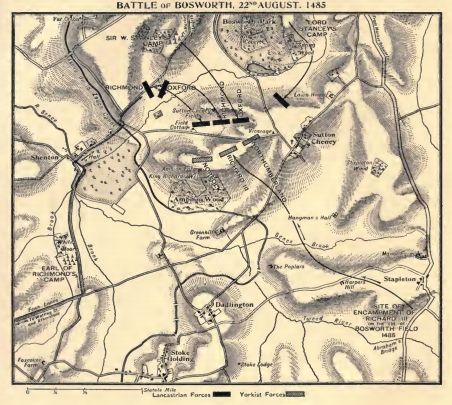 |
| Plan of Battle of Bosworth |
The following day, August 22nd, Richmond and Richard
engaged on Bosworth Field, the battle opening with the archers on each side
firing into their enemy’s troops. Richard led the central body of his army
forward himself, clad in the same burnished armour he had worn at the Battle of
Tewkesbury and wearing a royal circlet on his helmet. He was flanked on each
side by men of the Stanley contingent and these, on a sign, began to attack
Richard’s men.
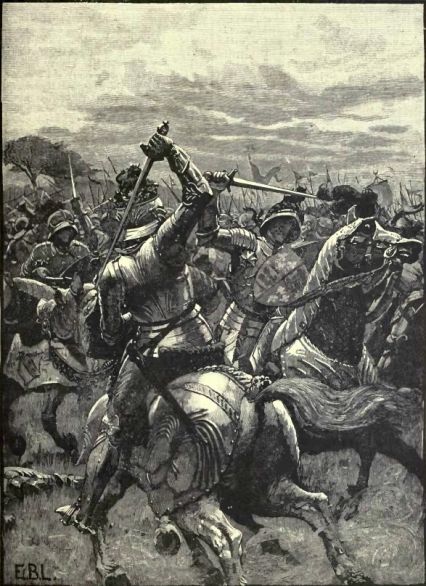 |
| Battle of Bosworth Field |
Richard, seeing that the Duke of Northumberland was also holding
back, led a direct attack on Richmond’s position; he made three charges in an
attempt to kill Richmond, he killed Richmond’s standard-bearer, Sir William
Brandon, with his own hands, struck Sir John Cheyney from his horse and launched
himself on Richmond himself, when the Stanleys arrived, surrounded him and
hacked him down. He fought, it was said, with tremendous spirit, courage and
strength, distinguishing himself in battle. It was said that the circlet that
Richard wore was hidden in a hawthorn bush by a soldier, but was recovered and
given to Lord Stanley, who crowned Richmond as King Henry VII on the
battlefield of Bosworth Field.
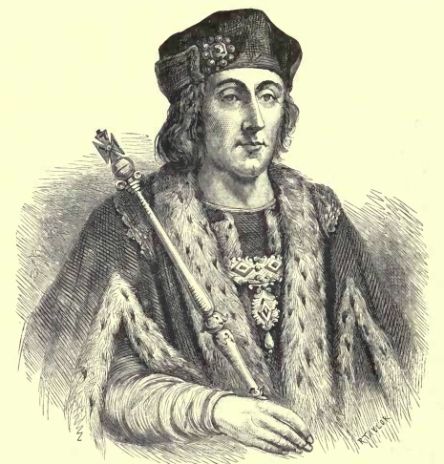 |
| King Henry VII |
Although there followed other, smaller,
engagements (Stoke Field, for example), Bosworth was effectively the final
battle of the War of the Roses.
What happened next to Richard III forms a
fascinating codicil to the story.
No comments:
Post a Comment